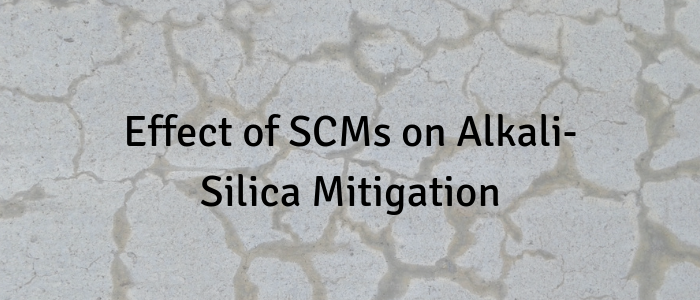Effect of SCMs on Alkali-Silica-Reaction Mitigation

1- Fly Ash
the three characteristics of fly ash that determine its efficiency in preventing ASR are fineness, mineralogy, and chemistry. In general, the finer the fly ash, the more efficient it is in reducing ASR expansion. An ultra fine fly ash, with particle size around 3 μm, can still be very effective despite a somewhat higher CaO content of approximately 11.8%. The mineralogy of each ash can react differently due to how the chemical components are bound. Studies have found that the CaO content has the greatest effect on a fly ash’s efficiency in mitigating ASR. The higher the CaO content, the less effective the fly ash is at reducing ASR expansion. Increased quantities of SiO2 have also proven to lower expansion.
Studies have shown that appropriate replacement levels of fly ash can prevent expansion due to ASR. ASTM C 618 Class F fly ashes have lower CaO contents than ASTM C 618 Class C fly ashes and can mitigate ASR at lower replacement levels. Class F fly ash is also more effective than Class C fly ash in reducing the pore solution alkalinity. For a particular fly ash, as replacement levels increase, expansion due to ASR decreases.
2- Ground Granulated Blast Furnace Slag
Ground Granulated Blast Furnace Slag (GGBFS) is a hydraulic cement primarily made of silica, alumina, calcium oxide, and magnesia. When GGBFS is hydrated, its silica and calcium oxide react and produce calcium silicate hydrate (C-S-H). Excess silica from the GGBFS and calcium hydroxide from the hydration of the portland cement react and form even more C-S-H. The cementitious characteristics of the GGBFS allows for high replacement values ranging from 25 to 70%.
ASTM C 989 separates GGBFS into three grades depending on their activity index: 80, 100, and 120. Studies have shown only grades 100 and 120 are successful in controlling ASR expansions. The equivalent alkali content of GGBFS is also limited by ASTM C 989 to a range of 0.6% to 0.9%. Alkalis within GGBFS are released into the pore water slower than those in the cement but faster than those in fly ash.
3- Silica Fume
Silica fume does not eliminate potential ASR expansion but delays the onset of the reaction. Silica fume promotes pozzolanic reaction with calcium hydroxide and alkaline hydroxides forming increased quantities of C-S-H, which leads to a higher density and less permeable concrete. Silica fume is prone to lumping when used in powder form. Silica fume granuals as small as 40 to 800 μm can act like reactive aggregates and actual cause ASR.
Therefore, it is suggested that mixtures containing silica fume have an extended mixing time to facilitate dispersion. Silica fume that does not meet ASTM C 1240’s silica content requirement of at least 85% has been shown to be unsuccessful in mitigating or delaying ASR. The use of silica fume is only effective for mitigating ASR for moderately reactive aggregates.
4- Metakaolin
Metakaolin reacts with calcium hydroxide, also known as portlandite, which forms supplemental C-S-H in concrete. This supplemental C-S-H entraps alkalis and consequently decreases the pH of the concrete pore solution. The decreased pH may suppress ASR expansion.
Read Also
